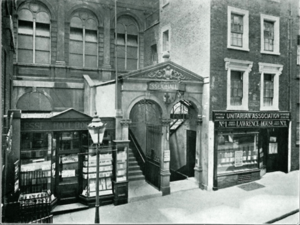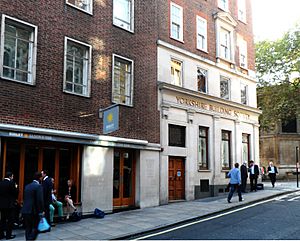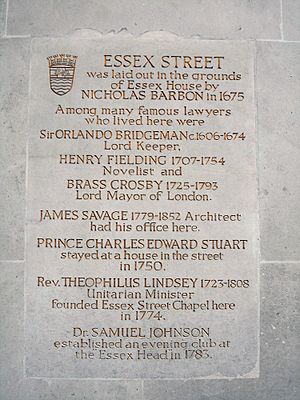Essex Street Chapel facts for kids
Essex Street Chapel, also known as Essex Church, is a Unitarian place of worship in London. It was the first church in England created for people with Unitarian beliefs. It started when people who didn't follow the main Church of England, called Dissenters, still faced legal problems.
Because it was the start of British Unitarianism, Essex Street is linked to many important social reformers and thinkers. The church moved to a new location in the 1800s. The original building then became the main office for Unitarian groups. Today, the main Unitarian organization in Britain, the General Assembly of Unitarian and Free Christian Churches, still has its offices there. This building is called Essex Hall. This article tells you about the buildings, the history, and the church today, which is in Kensington.
Contents
The Original Building
The first chapel was near the Strand in London. It was built on land where a large house, Essex House, once stood. This is why the street and the hall are named Essex. The location was handy, between the City of London and Westminster.
Before the chapel, parts of the old house were used by a bookseller. This space was easy to change into a simple meeting house. Soon, there were enough people and donations to build a new church. This new building was finished in 1778.
Important people like Francis Dashwood, 11th Baron le Despencer and Thomas Brand Hollis helped pay for it. Samuel Heywood, a chief judge, was also a supporter. The new building might have used the old chapel's foundations. The chapel did not get an organ until 1860.
History of Essex Church
How Unitarianism Began Here
The first minister at Essex Street Chapel was Theophilus Lindsey. He had left the Church of England because he believed in Unitarian ideas. He came to London to find others who thought like him and to start a new church group.
He quickly got help from important English Presbyterian ministers. These included Richard Price, who had his own church, and Joseph Priestley, who famously discovered oxygen. Unitarian beliefs were against the law until 1813. However, legal issues were solved with help from John Lee, a lawyer who later became Attorney-General.
The first service was held on April 17, 1774. People from far away, like Leeds, heard about it. They said the service was well-attended and that Lindsey's sermon was kind and welcoming. Two hundred people came to hear him speak. This included Benjamin Franklin, who was visiting from America. This was the first time in England that a church was openly formed around Unitarian beliefs.
Moving to Kensington
By the 1880s, many people had moved out of central London. This meant fewer members attended the Essex Street Chapel. In 1867, Reverend Robert Spears had already started a Unitarian group a few miles west. This group grew but did not have a permanent home.
Sir James Clarke Lawrence, a former Lord Mayor of London, bought and gave land in Kensington. A temporary church made of corrugated iron was built there. Meanwhile, the main Unitarian organizations needed better offices.
So, it was decided that the Essex Street building would be used for offices. The chapel would move to Kensington and join the other group. It would also bring money to build a beautiful new church there.
The new church in Kensington opened in 1887. It was called Essex Church. Over time, the building started to wear down. Air pollution damaged the stone, and the steeple was removed in 1960 because it was unsafe. In 1971, the roof was damaged by ice from an airplane. By the 1970s, the whole building needed repairs. It was taken down and replaced with a modern church. The first service in the new building was in July 1977.
Essex Hall Today
In the mid-1880s, the original Essex Hall building was rebuilt. The new design included offices, meeting rooms, a bookshop, and a large hall for 600 people. It was finished in 1886, a year before the Kensington church. Its opening service was a big event for British Unitarianism.
The hall was rented out for concerts and public meetings. The Fabian Society, a famous political group, often met there. Public meetings could sometimes be very lively. For example, in 1919, an American speaker named William "Pussyfoot" Johnson was injured during a public meeting at Essex Hall.
During World War I, a nearby building was used as a hostel for soldiers and sailors. In 1925, changes were made to Essex Hall to help a publishing company. From 1928, the main Unitarian group, the General Assembly of Unitarian and Free Christian Churches, operated from Essex Hall.
Much of Essex Street was destroyed by bombs during the Blitz in 1944. After the war, the site was a car park for a while. Eventually, plans and money were found to build new offices. The architect, Kenneth S. Tayler, saw the destruction as a chance to rebuild. The new building was finished in 1958. About half of the building's space was rented out to other groups to help pay the costs. For 14 years, while the new building was being constructed, the Unitarian work was done from Dr Williams's Library.
Current Church
Essex Church, also known as Kensington Unitarians, is located at Notting Hill Gate in Kensington, West London. It has Sunday services and small group activities. The current leader is Rev. Dr. Jane Blackall. She became a minister after working in medical imaging.
People Connected to Essex Church
Many interesting people have been part of the Essex Street Chapel and Essex Hall story:
- Augustus FitzRoy, 3rd Duke of Grafton: A politician who was an early member of the church.
- Samuel Shore: A banker and trustee of the chapel.
- William Sturch: A writer on religious topics, part of the first group of members.
- William Wilberforce: A famous young politician.
- William Frend: A social reformer who met Theophilus Lindsey and Joseph Priestley here.
- William Smith: A Member of Parliament and a leader in the movement to end slavery. He helped make Unitarianism legal in 1813.
- Henry Crabb Robinson: His detailed diaries are kept at Dr Williams's Library.
- Mary Hays: An author and friend of Mary Wollstonecraft.
- Frederick Nettlefold: Served as president of Unitarian associations and gave a lot of money.
- Nathaniel Bishop Harman: An eye doctor and author. His wife gave the largest donation for the 1958 Essex Hall building. His family includes politician Harriet Harman and writers like Lady Antonia Fraser.
- Rupert Potter: Father of the famous author and conservationist Beatrix Potter.




